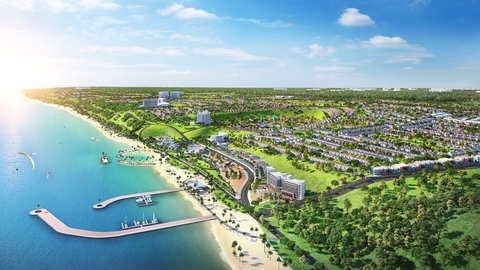Smarter buildings for a smarter city
Smarter buildings for a smarter city
As cities get smarter, they are becoming more liveable and more responsive – and today we are seeing only a preview of what technology could eventually do in the urban environment. Fulvio Bartolucci, general manager of Shanghai-based Adenergy which provides energy optimisation and automation platform solutions, talked with VIR’s Uyen Tran on how technology enables smart buildings and the growing role of the Internet of Things platforms in energy mangement.
How important are smart buildings in creating a smart city?
They are essential. By definition, a city is an area with a lot of buildings. Likewise, a smart city must be an area with a lot of smart buildings. I would only add that public spaces are also part of a smart city. There are smart parks, smart roads, and so on.
How would you explain the relationship between a smart building and the smart city?
In a way, you can compare smart buildings with Legos. Imagine a smart building as one Lego piece. Now, Lego pieces have different shapes and s, but the basic characteristic is that any one piece can connect to any other piece. And, when you start connecting the pieces, you build something bigger and more interesting, with endless configurations. That is how it works for smart buildings, with the end result being a smart city.
In a smart city, the pieces might be shopping centres, offices, apartments, factories – the more the better. The key is that each smart building is connectable with all the other buildings and spaces.
The thing connecting smart buildings is data - the huge, two-way flow of information between buildings. What are the tools used to create a smart building?
Exactly. Data collected throughout each building and its surroundings, and by the people who use them. And that is linked over the internet by data platform and hubs. This is the internet of things (IoT), of people, and of everything. When it comes to tools, you definitely work with sensors a lot. And in fact, any commercial or industrial building will have some sensors in place, even buildings that are not smart – there are meters for power, we have temperature sensors for heating, ventilation, and air conditioning (HVAC), and many buildings have some form of basic people-counting.
You can already get an initial picture by combining these basic data sources, but, generally, the insights you get about what happens in the building will be very basic. The optimisation options will be limited. Ideally, you want to get a much more detailed, granular understanding.
So you are saying there are different levels of smartness?
What I am saying is, with support from someone like Adenergy, most commercial buildings already have the equipment they need to reach a basic level of “smartness.” But what is exciting is that there is no top limit for smart buildings: it all depends on the objectives you want to achieve. There is no maximum on how much data you can collect.
Really, no limit at all?
Almost none. But there is an important point to make here: data is not magic. It is a strategic tool that needs skillful use. Collecting massive data is valuable only if you know what you are looking for, what your targets are, and how you will create real change when the data speaks. That is why strategic partnership with clients is as important to Adenergy’s business as our IoT technology and platform. It is true that the more data you collect, the more precise your models can be. But, practically, it is also crucial that people in the organisation see changes being implemented and experience the improvements for themselves. Otherwise, you risk doing a lot of work and spending a lot of money for nothing. The huge data pool companies dream of can turn into more of a data swamp if you have not planned carefully.
Why do you think companies do not have a clear view of their consumption dynamics?
There is more than one answer to that. On one hand, building operating expenditure (OpEx) is not always the number one value-driver for asset managers.
The second challenge is that the information needed to make sense of the situation is kept in different silos, and people do not see the full picture. There are a number of costs which are normally hidden in different parts of an organisation – energy cost is not just how much you spend on energy per se. It is also how many people must be employed to do certain work, or how much maintenance and replacement costs are. It is money you lose because a certain system is not working. That is why it is so important to start by clarifying the baseline and make the data available in a common platform, where it can be analysed and correlated.
So, let us say this initial stage is complete and we want to take next steps. What then?
Generally, after you have clarified the starting situation and analysed the data, some areas will pop out as having more room for improvement. Then you look at the building owner’s other priorities. Maybe they want to improve the productivity of the space, for example. In any case, at this point you set specific objectives for the project – let us say, for example, a 10 per cent improvement in HVAC efficiency or decreasing maintenance costs by 15 per cent. At this point, we would map the equipment and data we need to reach the target. We would find out what is available and what is realistic to achieve with a simple upgrade. We would also want to include some “human sensor” data, preferences, and experience information.
That is all taken from sensors inside the building. But you have to remember that smart technology is about information exchange, so you want to correlate with external data like weather and traffic information.
The key is that you view internal and external information together – data in an interconnected relationship.
When you partner with clients, what is your process for deciding how much data to collect?
It is like I have already said: you start by defining the end game. You must understand the reason for setting up the platform. What targets does the client have? What do they want to manage and to what degree? Then you start to understand if additional sensors and data collection are required beyond what the client already has.
In some cases, clients might just want to make better use, or more integrated use, of their existing data. Building owners can already get lots of data through existing building management systems and energy management systems. The problem is that this information usually disappears. It just becomes numbers on an occasional report from a technical guy if you are lucky. What we do is put all this information to use by periodically optimising and improving the way the building operates.
When property managers convert their buildings to be smart, is energy always the best place to start?
It is definitely a very safe starting point. The advantage of focusing on energy first is that it quickly generates savings for the owner, no matter how developed or under-developed the smart city infrastructure is. Regardless, the business will create some savings from energy optimisation. At the same time, this energy platform is setting up the infrastructure you need to further develop your smart building.
The longer-term payback is that once that connection is up, and the smart city continues its development, you can plug in so much more information to optimise other services and improve the value of your building. But even before then, optimising energy operations has measurable payback. Everything that follows is able to piggyback on that first energy infrastructure.
What are the differences between converting an existing property into a smart building and starting from scratch? Is one easier than the other?
I would not say one is necessarily easier than the other, they both have their own challenges and benefits.
For an existing property, your “hard challenge” is upgrading and integrating new parts with old ones. And you have the “soft challenge” of getting engagement from the people in the building – they have been working in the same building for years, but now you want them to operate as a smart building. They may need to break long-time habits and ways of doing things.
On the positive side, when you convert an existing building, it is very easy to quantify the value of becoming smart. Number-by-number, you can clearly see the before-and-after wins in savings and efficiency.
Building an all-new smart building is different. The positive is that it is a fresh start, so you can do things right from the beginning. There is no infrastructure bias. The challenge is that there is no mutual baseline to compare with, no before-and-after, so demonstrating the value is not as simple. One way we can show new smart buildings’ value is through very granular data we collect from our IoT energy platform, AEMO.
Who are the target users for the AEMO platform?
When we developed the platform, we wanted a tool that has two faces. One side is geared towards technical people, the energy specialists. Obviously, at Adenergy we are industry specialists, so we made sure it provides us with very detailed analytics that we can use to optimise the maintenance and management of energy systems. Mainly, this side of AEMO is Adenergy’s tool to squeeze out every last bit of efficiency when we manage a facility for our clients, although it is also available to clients. On the other side, we designed a client-facing version of the platform that can be customised and accessed in real time. We wanted it to look and function like a web or app interface, and to create a dynamic picture of current and past energy consumption. The idea is that each client will have a tool in their own hands to see the evolution of their energy use patterns and be able to do some of their own metrics analysis.
But unlike the specialist side of the app, we did not want to overload it with data. The idea is that we help clients tailor the platform to their own metrics and then see the data points they have identified as important.

















